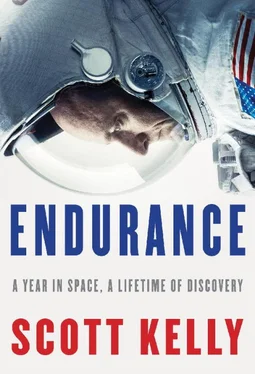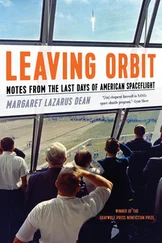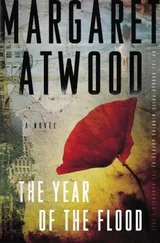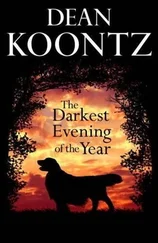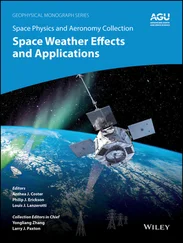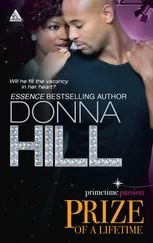“There’s a low risk of infection at the biopsy site—that’s really the only risk. People sometimes put it off as long as they can, though, because the procedure is uncomfortable.”
“How uncomfortable?” I asked.
Dr. Miles paused while he thought about how to explain it. “Like small electric shocks through the wall of your rectum,” he said.
“That sounds more than uncomfortable,” I said, “but let’s do it.”
The procedure was as unpleasant as he said, but I didn’t want to spend the next six months waiting to find out if I had cancer. If I did have it, I wanted to take care of it as soon as possible. Waiting could jeopardize my chances to fly my next mission or put the ISS schedule at risk.
A few days later, I learned I had a relatively aggressive strain of prostate cancer. Some types are so slow growing that men can live with them for decades and not be affected. The type I had would not create any adverse effects for a while, but if left untreated it would likely kill me in twenty years or so (I was forty-three).
When you are told you have cancer, especially an aggressive one, your mind immediately runs wild. Is this pain in my arm a metastasized tumor? Is the cancer spreading to my brain? I think this is a normal reaction to have, even for people who have access to top-notch care. I was immediately sent for a full-body CAT scan, and there was no indication the cancer had spread, which did a lot to set my mind at ease.
One of the first people I spoke to was my crewmate Dave Williams, who had had surgery for prostate cancer himself. As a doctor, he was able to offer good advice. He went to several meetings with me to talk to the surgeon about treatment options, along with the NASA flight surgeons.
Meanwhile, I called my brother and told him to get himself checked out. Since we were identical twins, we had a nearly identical genetic blueprint and therefore similar risks. When Mark got checked, it turned out he had the same type of prostate cancer.
I decided on a robotic radical retropubic prostatectomy, a surgery that would remove the entire prostate and leave me with a daunting recovery. It also brought with it a risk of bad outcomes like impotence or incontinence. There were less aggressive options—radiation therapy or a combination of less drastic surgery and radiation. It could take up to two years to determine whether radiation had successfully eliminated the cancer, though, and I didn’t want to have to wait that long to fly again. More important, because astronauts are exposed to radiation in space, our flight surgeons keep track of a lifetime radiation limit for each of us. I didn’t want to run up my lifetime limit if I could possibly avoid it. The robotic surgery was the option most likely to wipe out the cancer for good and minimize the risks to my career.
I underwent surgery in November 2007. My recovery took a long time, just as my surgeon had said it would, and it wasn’t fun. I had a urinary catheter for a week and a drain for lymphatic fluid in my side for weeks. One of the flight surgeons stopped by my home to check on my recovery one evening, and he decided the drain catheter was ready to come out. Standing in my living room, he simply yanked it out with all his might, and without much warning. I had no idea the thing was three feet long until I saw, and felt, it being ripped out of my body. I felt like I was William Wallace getting eviscerated in the movie Braveheart.
Despite the long recovery overall, I was aggressive in getting my NASA qualifications back, and I was able to start flying again in January. Getting back into the pool where we do spacewalk training, however, took much longer, as there was concern that the crotch of the spacesuit would put pressure on the area that was still healing. Due to the skill of Dr. Miles and the NASA flight surgeons, I returned to near normal in due time. The following year, I was in the operating room while Dr. Miles performed Mark’s operation, and I got to hold Mark’s prostate in my gloved hand before it was sent to pathology. The tumor was on the opposite side from mine, a mirror image, just like the opposite birthmarks on our foreheads.
—
IN EARLY 2008, I started training for my mission to the space station in earnest. I would be launching with two Russians, Sasha Kaleri and Oleg Skripochka, and when we got to orbit we’d be joining Shannon Walker, Doug Wheelock, and Fyodor Yurchikhin. Three months into my mission, Shannon, Doug, and Fyodor would return home and be replaced by Cady Coleman, Italian astronaut Paolo Nespoli, and Dima Kondratyev. I traveled often to Russia, Japan, and Germany to train with their respective space agencies.
I had a lot of experience working with the Russians in Star City by this point, which was good, because it would lighten my training load some, but I would still spend a significant amount of my time there. I’d learned a great deal about the differences between our cultures—that Russian people’s behavior toward strangers is indifferent to the point of seeming cold, which to Americans can feel rude, but that once I got to know individual Russians well, their behavior toward me was warm and affable. My friendships with people there reached a depth that would take many Americans years to reach.
The instructors we had at the European Astronaut Centre in Cologne, Germany, came from countries throughout Europe. I found it enriching to work with such a diverse group of people, but the training culture itself was purely German—precise almost to a fault. This could be a bit maddening at times to someone like me, who doesn’t care how the sausage is made. I prefer to be told what needs to be done and how to do it, leaving the nuanced details for the ground to worry about. I spent four weeks training in Cologne. I was enamored of the architecture, particularly the High Cathedral of Saint Peter, a thirteenth-century colossus that stands proudly on the banks of the Rhine.
Compared to my Russian and European colleagues, the Japanese people I met were much more outwardly polite and deferential to strangers, but it took much longer to get past that polite stage and get to something more familiar. Because my Japanese colleagues were polite to everyone, I found it hard to tell whether I had established good working relationships with them. This concerned me because I knew my directness could often be taken the wrong way and for some be off-putting.
To train with the Japanese space agency, I traveled to Tsukuba, a city of about 200,000 located about fifty miles northeast of Tokyo. I was joined there by my future crewmate Doug Wheelock and by Tracy Caldwell from my STS-118 crew, whom I was now backing up prior to my own expedition. One evening as we walked to one of the nearby restaurants, we passed a dessert truck with an English inscription on one side. In large letters, the truck was labeled “Marchen & Happy for You,” under which was printed an odd sort of prose poem:
Beginning was from only one car.
Fumisyasu Hasebe who is the founder who was 23 years old
A little brought the method of the vehicle sale completely different from former close to a grope and completion in 1998.
Creation of the scrupulous interior and jokespace.
The way a visitor can share not only the taste but a style.
It is thought of wanting to provide many people with a joke style with a delicious dessert.
It is the language and “Marchen & Happy for you,”
Which do not change now, either but are hung up.
It does not still change at all. And present
The top in the field of move sale is aimed at and it is under business in various parts of national.
It is our shop also to your town.
The first time we saw this truck, we stopped and read the “poem” out loud, fascinated by its almost-sensical approximation of colloquial English. The Marchen & Happy for You truck became a landmark for English speakers visiting Tsukuba, and we always made sure to point it out to newcomers, watching while they read it and tried to make sense of it. I took a picture of it with my phone one day and showed it to one of the instructors at the Tsukuba Space Center who had strong English skills. I read him the text and asked him, “Does this make any sense to you?”
Читать дальше
